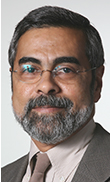Prof, students create guidelines for new veterinary building design

Valerian Miranda
Veterinary medicine education at Texas A&M will begin its second century in a new 300,000 square-foot, $120 million complex that was designed based on a programming effort by Valerian Miranda, head of the College of Architecture’s [CRS Center for Leadership & Management in the Design & Construction Industry] (http://crs.arch.tamu.edu) , architecture and environmental design students.
"Now we will have a building that truly matches the excellence of our faculty and students," said Eleanor Green, dean of veterinary medicine, during the April 29, 2014 [groundbreaking] (http://www.theeagle.com/news/local/texas-a-m-celebrates-new-vet-center-equine-complex/article_91d2bb21-262a-57ec-b538-6ca95881768c.html) at the site of the [Veterinary and Biomedical Sciences Education Complex] (http://vetmed.tamu.edu/news/press-releases/texas-am-breaks-ground-for-new-veterinary-biomedical-sciences-education-complex/vbec-architectural-renderings) , which is scheduled for completion in 2016.
Miranda and the students created the project’s architectural program, which includes the general direction the design of a building should take, by first learning what the client’s goals and needs are.
The students, who were involved in every part of the programming process, conducted more than 50 interview sessions with administrators, faculty, staff and students at the College of Veterinary Medicine and Biomedical Sciences. They also measured and cataloged the use of each room and space in the existing facility to determine all of the college’s current space utilization.
“Interviewing and cataloging helped us better understand how the client operated in their current space and what space requirements we needed to include for the new facilities,” said Megan Irvin, an architectural intern at [Kirksey] (http://www.kirksey.com) , a design firm in Houston. Irvin, who led the student programming team as a [Master of Architecture] (http://dept.arch.tamu.edu/graduate/) student, earned her graduate degree in 2014 and a [Bachelor of Environmental Design] (http://dept.arch.tamu.edu/undergraduate/) degree in 2012.
Students Crystal Dyll, Andrew Gazda, Daniela Lambarri, Tyler Nagai, Jennifer Sitton and Clinton Stanford were also on the programming team, which began its work in late spring 2012 and finished in early summer 2013.
The information was organized and analyzed to create the program, a large set of documents that includes a “big picture” and many smaller details, including concepts of building configurations and size, how many and what size classrooms and labs are needed, what kind of equipment is needed in the rooms and minutiae including the quantity of lights and electrical outlets in each room.
Students, said Irvin, learned how to use the programming process to mold the mountain of information they compiled into a successful program of space requirements and concepts that could be carried through the remainder of the project.
“When we started to put all the information together, a pattern of buildings around a central court emerged, and that’s the way the architects ended up designing it,” said Miranda. “All the information generated out of this project formed a handover package to the architects who used it to design the facility.”
The programming team, said Miranda, learned that people in the veterinary college felt that faculty, students and staff weren’t interacting enough in their old building.
The team included this concern in the program, recommending that people in the new buildings cross paths to get to where they were going — to get essential services for example — to increase everyone’s interactions, said Miranda. “We also recommended that break rooms become multipurpose spaces … interviewees were really excited about these ideas.”
“These concepts are in the final architectural design, which means that the design came from the people who are actually going to use the building, which makes it that much better,” he said.
“Programming the facility was a great opportunity to learn how to take a large, complex project, identify what the client wants versus what they need and break that knowledge down into smaller, more manageable pieces in order to find the best solutions for the client,” said Irvin. “Problem solving is key in architecture and these skills will serve me for the duration of my career.”
Miranda became well-versed in programming when he began working at the legendary architecture firm [CRS] (http://crs.arch.tamu.edu/about-us/history/) in 1984 with firm partner and former student [William Peña] (http://crs.arch.tamu.edu/archives/people/pena/) ‘42, often referred to as the “father” of architectural programming. Peña completed more than 400 programs and co-authored the first edition of “ [Problem Seeking] (http://www.wiley.com/WileyCDA/WileyTitle/productCd-1118084144.html) ” in 1969, which remains a standard textbook in architectural education. The book’s fifth edition was published in 2012.
Peña is an outstanding alumnus of Texas A&M’s College of Architecture, a member of the American Institute of Architects’ [College of Fellows] (http://network.aia.org/cof/home/) , and the [recipient] (http://one.arch.tamu.edu/news/2013/12/4/pena-receives-medal/) of the French Legion of Honour Medal for helping to liberate France as a member of the U.S. Army in September 1944.
Tags
- academics
- architecture
- building a better texas
- crs center
- crs gallery
- feature
- graduate work
- outreach
- partnerships
- rss
- undergraduate work
Related Posts

Public interest design projects recognized

BED student designs 'Real Projects' home

Student-designed, built ‘tiny’ homes to house homeless
Study eyes impact of acoustics on autistic

Treatment center designs aid PTSD, head-injured vets
Follow Us
Facebook Twitter Vimeo Youtube Flickr RSS
Recent Posts

Planning prof heads study of disaster housing aid

A message from the dean

Former student remembered as expert planner

Leading educator named new head of Architecture Dept.







_thumbnail_small.png)
